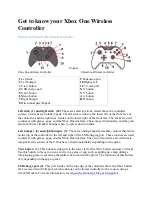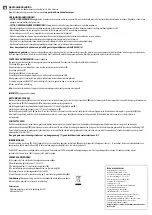
5-148
F35 MULTIPLE FEEDER PROTECTION SYSTEM – INSTRUCTION MANUAL
PRODUCT SETUP
CHAPTER 5: SETTINGS
5
suitable for use in power system protection, control, automation, and data communication applications, and thereby
facilitates interoperability between different vendor’s clocks and switches. PP specifies a worst-case delivered time error of
less than 1
µs over a 16-hop network.
In a PTP system and in a PP system, the clocks automatically organize themselves into a master-slave synchronization
hierarchy with the “best” clock available making itself the "grandmaster" at the top of the hierarchy; all others make
themselves “slaves” and track the grandmaster. Typically the grandmaster clock receives its time from GPS satellites or
some other link to the international time standard. If the grandmaster fails, the next “best” clock available in the domain
assumes the grandmaster role. When a clock on start-up discovers that it is “better” than the present grandmaster, it
assumes the grandmaster role and the previous grandmaster reverts to slave. The F35 qualification mechanism accepts a
potential master clock as a new grandmaster, when in a four-second interval it has received three announce messages
from it, all better than the present grandmaster clock and better than any other announce in this interval.
Time messages issued by the grandmaster are delayed as they pass through the network both due to the finite speed of
the signal in the interconnecting fiber or wire, and due to processing delays in the Ethernet switches. Each clock and switch
implementing PP measures the propagation delay to each of its PP neighbors, and compensates for these delays in the
time received. Each network device implementing PP measures the processing delay it introduces in each time message
and compensates for this delay in the time it transmits. As a result, the time delivered to end-devices such as the UR are
virtually identical to the grandmaster time. If one of the network devices in the hierarchy does not fully implement PP, the
associated propagation delay and/or latency may not be compensated for, and the time received at the end-device can be
in error by more than 100
µs.
See the preceding Real Time Clock section for a description of when time values received via PTP are used to update the
relay’s real time clock.
The following settings are available for configuring the relay for PTP. The PTP menu displays only when the option was
purchased.
STRICT POWER PROFILE
— Power profile (IEEE
Std
C37.238 2011) requires that the relay only select a power profile compliant
clock as a grandmaster, that the delivered time have worst-case error of ±1
µs, and that the peer delay mechanism be
implemented. With the strict power profile setting enabled, the relay only selects as master the clocks displaying the
IEEE_C37_238 identification codes. It uses a port only when the peer delay mechanism is operational. With the strict power
profile setting disabled, the relay uses clocks without the power profile identification when no power profile clocks are
present, and uses ports even if the peer delay mechanism is non-operational. This setting applies to all of the relay’s PTP
capable ports.
PTP DOMAIN NUMBER
— Set this setting to the domain number of the grandmaster-capable clock(s) to be synchronized to. A
network can support multiple time distribution domains, each distinguished with a unique domain number. More
commonly, there is a single domain using the default domain number zero.
This setting applies to all of the relay’s PTP capable ports.
PTP VLAN PRIORITY
— This setting selects the value of the priority field in the 802.1Q VLAN tag in request messages issued
by the relay’s peer delay mechanism. In compliance with PP the default VLAN priority is 4, but it is recommended that it be
set to 7 in accordance with PTP. Depending on the characteristics of the device to which the relay is linked directly, VLAN
Priority can have no effect.
This setting applies to all of the relay’s PTP capable ports.
PTP VLAN ID
— This setting selects the value of the ID field in the 802.1Q VLAN tag in request messages issued by the relay’s
peer delay mechanism. It is provided in compliance with PP. As these messages have a destination address that indicates
they are not to be bridged, their VLAN ID serves no function, and so can be left at its default value. Depending on the
characteristics of the device to which the relay is linked directly, VLAN ID can have no effect. This setting applies to all of
the relay’s PTP capable ports.
PORT 1 ... 3 FUNCTION
— While this port setting is selected to disabled, PTP is disabled on this port. The relay does not
generate or listen to PTP messages on this port.
PORT 1 ... 3 PATH DELAY ADDER
— The time delivered by PTP is advanced by the time value in this setting prior to the time
being used to synchronize the relay’s real time clock. This is to compensate to the extent practical for time delivery delays
not compensated for in the network. In a fully compliant PP network, the peer delay and the processing delay mechanisms
compensate for all the delays between the grandmaster and the relay. In such networks, make this setting zero.
Содержание F35
Страница 12: ...1 4 F35 MULTIPLE FEEDER PROTECTION SYSTEM INSTRUCTION MANUAL FOR FURTHER ASSISTANCE CHAPTER 1 INTRODUCTION 1 ...
Страница 202: ...4 88 F35 MULTIPLE FEEDER PROTECTION SYSTEM INSTRUCTION MANUAL FLEXLOGIC DESIGN USING ENGINEER CHAPTER 4 INTERFACES 4 ...
Страница 562: ...6 30 F35 MULTIPLE FEEDER PROTECTION SYSTEM INSTRUCTION MANUAL PRODUCT INFORMATION CHAPTER 6 ACTUAL VALUES 6 ...
Страница 576: ...7 14 F35 MULTIPLE FEEDER PROTECTION SYSTEM INSTRUCTION MANUAL TARGETS CHAPTER 7 COMMANDS AND TARGETS 7 ...
Страница 650: ...A 38 F35 MULTIPLE FEEDER PROTECTION SYSTEM INSTRUCTION MANUAL FLEXANALOG ITEMS APPENDIX A FLEXANALOG OPERANDS A ...
Страница 658: ...C 6 F35 MULTIPLE FEEDER PROTECTION SYSTEM INSTRUCTION MANUAL COMMAND LINE INTERFACE APPENDIX C COMMAND LINE INTERFACE C ...
Страница 666: ...iv F35 MULTIPLE FEEDER PROTECTION SYSTEM INSTRUCTION MANUAL ABBREVIATIONS ...
Страница 682: ...xvi F35 MULTIPLE FEEDER PROTECTION SYSTEM INSTRUCTION MANUAL INDEX ...
















































